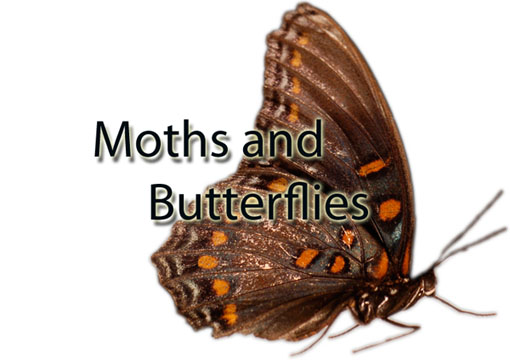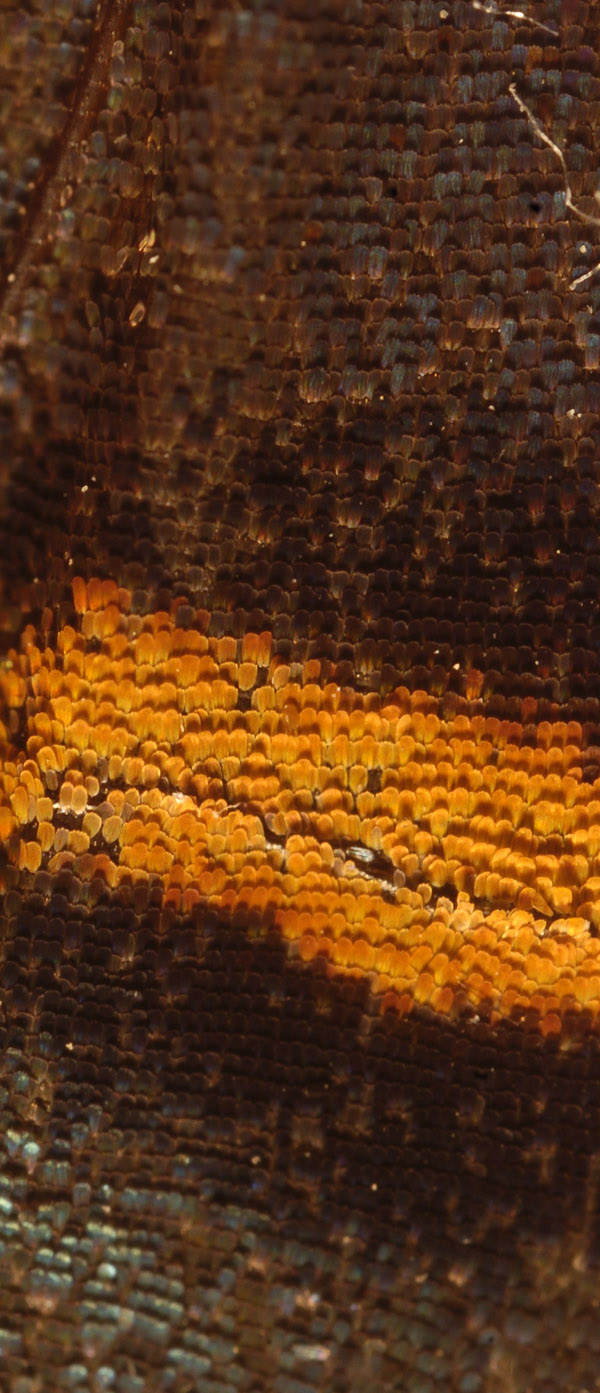
Somewhere inside the butterfly and moth, there are written instructions that set forth the exact placement of thousands upon thousands of tiny scales on their wings. These scales are individually colored with the obvious intention of forming colored designs. These scales are clearly not random, but were specifically intended to create a pattern and are organized into discrete rows and matching colors.
Here is a close up of the orange spot that is in the middle of the wing just above the "S" in the photograph at the top of this page:

Butterfly Wing
Note how each tiny scale is the same size but colored differently and placed in a design. There is even a discrete fading from brown to yellow. All of the scales are in rows and each one is in its place.
There is an obvious intent to create an overall design and complimentary colors on the wing.
There are no accidental scales falling randomly over the surface of the wing. Every on is in place.
Evolution's explanation for this is (and has to be) that all of the butterflies with some misplaced scales died because the butterflies with the advantage of properly placed scales were better able to survive. Is that how thousands of scales were arranged into discrete rows, columns and colors?
Did the accidental arrangement of thousands (millions?) of scales into this pattern really contribute to the survival of some primordial butterfly? Why are there no butterflies without (lovely) patterns on their wings? Why are they beautiful? How did they become perfected? Surely several scales out of thousands would not hamper survival.
Note also how the scales, like pixels on the computer screen, vary in intensity of color so as to create a picture intended to be seen from a distance. See how the colors form a transition from yellow to dark brown. There is an obvious intent to create not only different colors but also to create a transition between the colors. Note the interspersed blueish scales that create a sheen on the wing without changing the lovely underlying dark brown color.
A Creator designed the butterfly and the moth and He intended the colors on these wings to be complimentary brown and yellow and gold and to exhibit accents of yellow that fade into the dark brown background. And He created a bluish sheen that would shimmer in the sunlight.
This pattern and the colors are expressed not only on the wing, but are also written into a language (or code) that is expressed by the arrangement of the atoms of the DNA of this insect. It is this code (this arrangement of atoms and the molecules that the atoms compose) that describes and determines the chemical composition and the size and the color of each of thousands of individual scales.
Somewhere in the molecular structure of this insect there are atoms arranged into a code that defines precisely where each of these scales will be placed in order to form the design. The code specifies the row and the number and where the brown and the yellow and the transition between the yellow and the brown will be placed. This design was intended before the scales were colored, and the code had to be conceived before the atoms and molecules could be arranged in the correct sequence to utilize it.
How does one create a group of proteins that define the placement of the scales? Purely random chance, I am sure.
In order to argue that this insect was not the product of a Creator, evolution must make a presumption. And that presumption is simply that one cannot consider whether or not a Creator created the insect because that consideration is outside of the realm of accepted science. Such a consideration is not science. Since it is not science, it cannot be considered as an answer to a scientific question.
Therefore, accidental mutations and survival of the fittest wrote the design of the butterfly's wings into a code inscribed in a sub-molecular structure inside the cells that make up the insect. The same unobserved process provided the mechanism for the interpretation of that code and then utilized that interpretation to assemble the wings, placed each scale on each row in its place and simultaneously constructed the brain of the insect that operates the wings and computes at the rate of a trillion organized cycles per second.
Since evolution is founded upon the presumption that there is no God, any actual evidence for special creation is quite irrelevant to evolutionists:
"Even if there were no actual evidence in favor of the Darwinian theory ... we would still be justified in preferring it over rival theories [creationism]." Richard Dawkins, The Blind Watchmaker (NY Norton, 1986), 287.
Evolutionists don't really care if there is evidence for creationism because their system of belief renders God to be a nullity no matter what the evidence shows. So, to evolutionists, creationism is untenable ab initio no matter what. Evolutionists refer to this as "rational thought." Ironically, this "rational thought" is nothing more than a theological presupposition. See antiscientific argument.
Environmental pressures have just as much chance of transforming caterpillar into a butterfly as transforming an evolutionist into a Christian - or as much chance of creating a supercomputer the size of a pinhead (see honeybee) or a thousand trillion timed and organized connections that can think (see grass). How absolutely magnificent is the Creator who has made us and all these things.